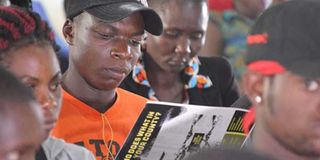Factor needs of youth in county plans

Young people follow proceedings during a Jiactivate county youth engagement programme in Manyata slums in Kisumu on March 5, 2018. County governments and other stakeholders must meaningfully engage the youth by ensuring that they participate in planning. PHOTO | ONDARI OGEGA | NATION MEDIA GROUP
What you need to know:
We must do all we can to ensure that the needs of the youth are adequately considered in the county plans.
A good starting point would be to deliberately include youth-friendly information formats and channels in information campaigns.
- Any county government interested in reaching the youth needs to adopt the use of other mass media channels other than newspapers.
Only seven out of 100 youth reported reading newspapers daily.
At the top of the new county governments’ ‘To Do’ list, as required by law, is strategic planning.
The County Integrated Development Plan (CIDP), a provision of the County Governments Act, 2012, is, effectively, the devolved unit’s strategic plan.
It ought to show well-defined goals and objectives, a costed implementation plan, framework for monitoring and evaluation, as well as clear reporting mechanisms.
It is the CIDP, then, that informs the county’s annual budget. Unfortunately, there is a real danger that young people’s needs will not be adequately factored in the CIDPs and subsequent annual budgets.
Those who make public policy decisions in Kenya are middle-aged or older.
The ‘National Manpower Survey Basic Report’ published by the government in 2014 showed that only three out of 10 — or 29 per cent — civil servants were under 35 years old.
ALIENATING GROUP
We must do all we can to ensure that the needs of the youth are adequately considered in the county plans. After all, they are the single-largest demographic group in Kenya: Four out of five Kenyans (80 per cent) are under 35.
To eliminate the possibility of alienating this potentially most productive group, decision makers and other stakeholders at the county level must take deliberate steps to ensure that the youth are at the front and centre of development plans.
Granted, young people in Kenya face many challenges, some of which are, however, not within the mandate of counties.
The National Youth Policy (2006), which is under review, identifies two struggles the youth face that counties can resolve: Health challenges and limited access to economic opportunities. CIDPs ought to address these.
The best way to ensure this is to have young people on board.
A good starting point would be to deliberately include youth-friendly information formats and channels in information campaigns targeting to educate communities about participation in the county development planning.
WONDERFUL INSIGHTS
A study published by Well Told Story in 2017 provides wonderful insights about young people aged 15-24 in Kenya.
Any county government interested in reaching the youth, it says, needs to adopt the use of other mass media channels other than newspapers.
Radio is the most dominant of those preferred by the youth, followed by broadcast television and social networking sites.
Newspapers, a medium preferred by county governments as a means of communication, was found by the study to be ineffective in reaching the youth.
Only seven out of 100 youth reported reading newspapers daily.
The study shows that the youth do not have adequate knowledge about governance. Just a quarter of those surveyed knew the roles of national and county governments and only 5 per cent could tell which department was responsible for particular issues.
It is not all doom and gloom, though. Many of the youth reported an interest in being part of governance with 37 per cent saying they would like to know the roles of national and county governments while 26 per cent wanted to know their rights as citizens.
As we head into the second round of devolution in Kenya, county governments and other stakeholders must meaningfully engage the youth for programmes and decision making to address their needs by ensuring that they participate in planning.
Ms Samba is the Kenya country director at Deutsche Stiftung Weltbevoelkerung (DSW). [email protected].




